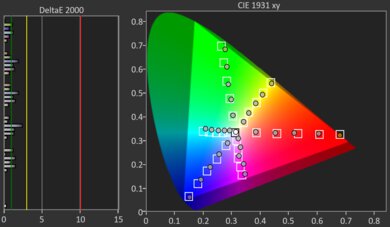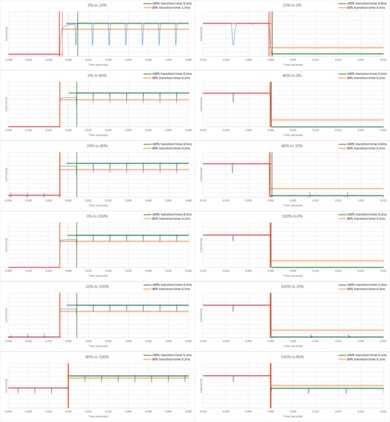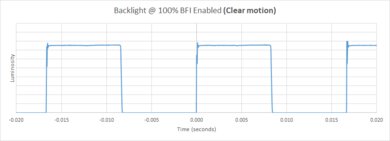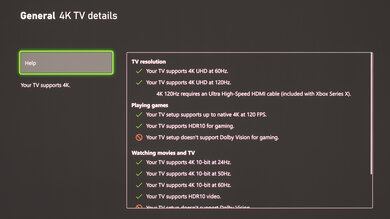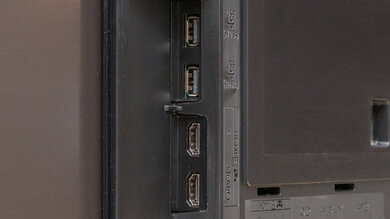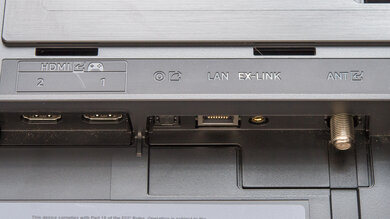The Samsung S95B OLED is a high-end 4k TV in Samsung's 2022 lineup and is Samsung's first OLED TV. It's different from Samsung's QLED lineup, such as the high-end Samsung QN95B QLED, in that this TV uses a QD-OLED panel. This TV technology uses blue OLED panels with quantum dot color filters and is advertised to deliver much brighter colors than traditional white OLED displays, like the LG G2 OLED. Like other Samsung TVs, it uses Samsung's proprietary Tizen OS smart interface, which offers a large selection of apps and games. There's also a large focus on gaming features, and the TV supports HDMI 2.1 bandwidth on all four ports and is FreeSync Premium certified. It was replaced in 2023 by the Samsung S95C OLED, which offers similar picture quality but an updated design and an external Slim One Connect input box.
Our Verdict
The Samsung S95B is a fantastic TV overall. Its self-emissive OLED technology is superb for watching movies or gaming in a dark room. HDR content looks fantastic thanks to its high peak brightness and exceptional color gamut. It also has an exceptional viewing angle, so you can enjoy an accurate image from any angle, making it amazing for watching sports or TV shows. Sadly, it uses an uncommon pixel layout that results in noticeable color fringing and blurry text, so it's not well-suited for productivity use as a PC monitor. It's also best suited for completely dark rooms, as it has raised blacks in a room with any ambient lighting, and the screen has a pink tint to it.
- Near-infinite contrast ratio for perfect blacks.
- Fantastic reflection handling.
- Incredibly bright colors.
- Aggressive ABL can get distracting with large areas of brightness.
- Raised blacks if it's in a room with any ambient light.
The Samsung S95B is a great TV for watching TV shows in a bright room. It has adequate SDR peak brightness and incredible reflection handling, although if you're in a room with any amount of ambient light, blacks appear raised, and there's a pink tint to the screen. It has an exceptional viewing angle, which is great for a wide seating area or, if you like to move around with the TV, as the image remains accurate. It also upscales lower-resolution content well, and the smart interface has a great selection of streaming apps, so you're sure to find your favorite shows.
- Fantastic reflection handling.
- Exceptionally wide viewing angle.
- Aggressive ABL can get distracting with large areas of brightness.
- Raised blacks if it's in a room with any ambient light.
The Samsung S95B TV is amazing for watching sports in a bright room. It has adequate SDR peak brightness and incredible reflection handling, although if you're in a room with any amount of ambient light, blacks appear raised, and there's a pink tint to the screen. It also has an exceptional viewing angle, which is great if you have a wide seating arrangement, as the image remains accurate even from the sides. It has a quick response time, so motion looks clear, and it has excellent gray uniformity, with very little distracting dirty screen effect.
- Fantastic reflection handling.
- Exceptionally wide viewing angle.
- Aggressive ABL can get distracting with large areas of brightness.
- Raised blacks if it's in a room with any ambient light.
The Samsung S95B is a superb TV for gaming. It has fantastic low input lag for a responsive gaming experience, and its OLED panel delivers incredibly smooth motion thanks to its nearly instantaneous response time. It also has a few great gaming features, including variable refresh rate support, and it supports HDMI 2.1 bandwidth on all four HDMI ports, so you can take full advantage of multiple high bandwidth sources, which is great if you have both the Xbox Series X and PS5.
- Fantastic reflection handling.
- Low input lag.
- HDMI 2.1 bandwidth on all four ports.
- Raised blacks if it's in a room with any ambient light.
The Samsung S95B is superb for watching HDR movies in a dark room. Its nearly infinite contrast ratio results in deep inky blacks if you're in a pitch-black room, and bright highlights stand out with no blooming or haloing. It has great peak brightness in HDR, so bright areas of the screen stand out the way the content creator intended. It also has amazing color volume and an exceptional color gamut, but some colors appear oversaturated.
- Near-infinite contrast ratio for perfect blacks.
- Automatically removes 24p judder from any source.
- Wide color gamut.
- Incredibly bright colors.
- Aggressive ABL can get distracting with large areas of brightness.
- Doesn't support DTS passthrough or Dolby Vision.
- Fast response time results in noticeable stutter.
The Samsung S95B delivers a fantastic HDR gaming experience. It delivers a superb gaming experience with low input lag, a nearly instantaneous response time, and a few additional gaming features, including HDMI 2.1 bandwidth and variable refresh rate support. HDR content looks superb thanks to its high peak brightness, exceptional color gamut, and nearly perfect contrast ratio. It's best enjoyed in a perfectly dark room, as the lack of a polarizer results in raised blacks if there's even a bit of ambient light.
- Near-infinite contrast ratio for perfect blacks.
- Low input lag.
- HDMI 2.1 bandwidth on all four ports.
- Aggressive ABL can get distracting with large areas of brightness.
- Doesn't support DTS passthrough or Dolby Vision.
The Samsung S95B delivers a fantastic PC gaming experience, but it's not well-suited for productivity, as there are some serious deal-breakers. It has an exceptional viewing angle, so the sides of the screen remain accurate if you're sitting close to it. It also has low input lag and a nearly instantaneous response time for a responsive, clear desktop experience. Unfortunately, even though it can accept and display a full chroma 4:4:4 signal, text isn't very clear due to the unusual subpixel layout, which can't be corrected with ClearType settings. It's also best enjoyed in a perfectly dark room, as the lack of a polarizer results in raised blacks if there's even a bit of ambient light.
- Fantastic reflection handling.
- Exceptionally wide viewing angle.
- Low input lag.
- HDMI 2.1 bandwidth on all four ports.
- Aggressive ABL can get distracting with large areas of brightness.
- Small risk of permanent burn-in.
- Noticeable color fringing.
- Raised blacks if it's in a room with any ambient light.
Changelog
- Updated Jul 08, 2025: We uploaded the latest brightness measurements and uniformity photos for the Accelerated Longevity Test.
- Updated Jun 12, 2025:
Removed the mentions of Google Assistant and Google Duo support from the review, since the TV no longer supports these features.
- Updated Apr 17, 2025: We uploaded the latest brightness measurements and uniformity photos for the Accelerated Longevity Test.
- Updated Feb 11, 2025: We uploaded the latest brightness measurements and uniformity photos for the Accelerated Longevity Test.
Check Price
Differences Between Sizes And Variants
We tested the 65-inch Samsung S95B OLED, which also comes in a 55-inch size. Note that the last five letters in the model number (AFXZA in this case) vary between retailers and individual regions, but there's no difference in performance.
| Size | US Model | Short Model Code |
|---|---|---|
| 55" | Samsung QN55S95BAFXZA | Samsung QN55S95B |
| 65" | Samsung QN65S95BAFXZA | Samsung QN65S95B |
Our unit was manufactured in March 2022, and you can see the label here.
Popular TV Comparisons
The Samsung S95B OLED is an incredible TV with exceptional picture quality. The new quantum dot OLED technology delivers incredible picture quality, with much brighter colors than traditional white OLED panels from LG and Sony, with the exception of the incredibly bright LG G3 OLED. There are a few downsides, though, as it really needs to be in a fully dark room for it to look its best, as blacks appear raised, and there's a pink tint to the screen if there's any ambient light. Conventional white OLED panels don't have this issue. If you're looking for a smaller OLED size than the S95B and are also interested in the idea of your TV acting as a gaming panel, check out the LG OLED Flex. It doesn't perform as well as the S95B overall, but it comes in a 42-inch screen size and can curve itself to look like a gaming monitor or stay flat like a TV.
See our recommendations for the best OLED TVs, the best 4k TVs, and the best TVs for watching movies.
The Samsung S90D OLED is a small but noticeable upgrade over the Samsung S95B OLED. The S90D is brighter in HDR and SDR, has better image processing, and supports 4k @ 144Hz on all four of its HDMI 2.1 ports, while the S95B is limited to 4k @ 120Hz. Some users online report that you can force a 144Hz signal on the S95B and that it works fine, but it doesn't work well on our unit, so your mileage may vary. Ultimately, the S90D is probably not worth an upgrade for most people, but it's definitely the superior set.
The Samsung S95B OLED and the Samsung S90C OLED are almost identical. Indeed, the S90C looks like a repackaged S95B but with official 4k @ 144Hz (120Hz on the 83-inch model) support, the 2023 version of their proprietary Tizen OS, and new 77" and 83" (with a WOLED panel) models alongside the existing 55" and 65" ones. The S90C is also a bit brighter than the S95B, but everything else is identical.
The Samsung S95B OLED is better than the LG C3 OLED. The Samsung TV is brighter than the LG in most usage. However, it can hold onto its brightness much better than the LG in Game Mode. The Samsung has a much wider color gamut than the LG; it can output vibrant, saturated colors, making the TV really pop. It also has much better HDR gradient handling than the LG, so you won't notice annoying banding in scenes with color gradients. The LG does have better low-resolution upscaling, so it will do a better job with low-resolution content or streaming content at low bitrates. The LG also supports every audio format, including DTS, so it's the better overall TV for a home entertainment setup.
The Samsung S95B OLED and the LG C2 OLED deliver a somewhat similar experience, but they each stand out in different ways. Colors are significantly brighter on the Samsung, and it can display a wider color gamut with HDR content. Skin tones look better on the Samsung, but some colors sometimes look unnatural. On the other hand, the LG has better black levels in rooms with a bit of natural light, whereas the Samsung is best enjoyed in a completely dark room. The LG supports Dolby Vision and delivers a slightly more accurate HDR experience.
Test Results

The TV has incredibly thin bezels, helping it to blend into your environment when it's not in use. Like all OLED TVs, the panel portion of the TV is incredibly thin. The overall design looks very similar to the Samsung QN90B QLED. The heavy central stand looks great and takes up very little space.
The results after four months have been updated after running the main pixel compensation cycle on the TV. After a firmware update released by Samsung, the large compensation cycle now runs automatically on the TV, and it's very effective at reducing the appearance of permanent image retention, but it doesn't remove it entirely.
| Color | Pre Compensation Cycle | Post Compensation Cycle |
| 50% Gray | Pre Picture | Post Picture |
| Red | Pre Picture | Post Picture |
| Green | Pre Picture | Post Picture |
| Blue | Pre Picture | Post Picture |
| Cyan | Pre Picture | Post Picture |
| Magenta | Pre Picture | Post Picture |
| Yellow | Pre Picture | Post Picture |
| 5% Gray | Pre Picture | Post Picture |
The center-mounted stand is relatively small. Due to the large size of the TV relative to the stand, it wobbles a bit, but it settles quickly. The stand lifts the display about three inches above the table, so most soundbars fit in front of it without blocking the screen.
Footprint of the 65-inch stand: 14" x 11.5"
The back of the TV is made up of two sections. The central panel that houses the electronics is made of smooth plastic. There are covers included to hide the inputs and to help with cable management. The inputs aren't easy to access if you wall-mount it with a fixed mount, especially once the covers are in place. The replacement model, the Samsung S95C OLED, uses an external Slim One Connect input box instead.
The TV has excellent build quality. The materials used feel premium, and there's very little flex to any of the panels. The stand supports the TV well, but there's a bit of wobble due to its large size. There's a slight bend to the main panel of the display, and just moving it around flexes it a bit, but this is common with OLED displays since they're incredibly thin. Unfortunately, the display shows fingerprints easily, and they can be difficult to remove.
Since OLED displays use self-emissive pixels instead of a backlight, the Samsung S95B has a nearly infinite contrast ratio. It allows it to control the brightness of each pixel individually, so it can display bright highlights right next to perfect blacks with no blooming or haloing.
With any display, deep blacks are mainly noticeable if you're in a dark room, but it's even more important with this TV as it lacks a polarizing filter, so blacks appear raised, and the TV has a slight pink tint to it if there's even a bit of light in your room.
The panel doesn't have a backlight, but thanks to its nearly infinite contrast ratio, it has the equivalent of a perfect local dimming feature with no zone transitions. We still film the zone transition video on the TV so you can see how the screen performs and compare it with a TV that has local dimming.
Update 18/12/2023: The TV is slightly dimmer with firmware 1602. While some of that dip can be attributed to the longevity test, the brightness difference since our last retest is too big to be attributed to the longevity test alone. Still, it's not a noticeable difference in actual usage.
The Samsung QD OLED has great peak brightness in HDR. Unfortunately, large bright scenes are still significantly dimmer than smaller highlights due to the TV's aggressive Automatic Brightness Limiter (ABL).
These measurements are after calibrating the HDR white point with the following settings:
- Picture Mode: FILMMAKER
- Brightness: Max
- Contrast: Max
- Color Tone: Warm2
Overall, the Samsung QD OLED is about as bright in 'Game' Mode as in 'FILMMAKER' Mode. It doesn't track the PQ EOTF as well, though, as most scenes are over-brightened, as you can see here. The TV is more accurate when you enable Game HDR, seen here, but now it's slightly too dim in dark and bright scenes.
These measurements are after calibrating the HDR white point with the following settings:
- HDR Picture Mode: Game Mode
- Brightness: Max
- Contrast: Max
- Color Tone: Warm2
- Color Gamut: Auto
The TV has great PQ EOTF tracking, so most content is displayed at the correct brightness level. Still, it's a bit too dark on all content, especially in darker scenes. For content mastered at 600 and 1000 nits, the panel clips anything above its peak brightness, so there's a loss of fine detail. Inversely, the TV slowly rolls off to its peak brightness with content mastered at 4000 nits, which preserves bright highlights.
Update 09/28/2023: The peak brightness of the TV changed after a recent firmware update. The TV is now much dimmer in SDR.
The Samsung S95B has adequate peak brightness in SDR. It's bright enough to overcome glare in bright rooms, but sadly, large, bright scenes are dimmed considerably by the TV's Automatic Brightness Limiter (ABL). This is mainly distracting when watching sports with bright playing surfaces, like hockey. Setting Peak Brightness to 'Off' effectively disables the ABL feature, but also reduces the peak brightness in all scenes.
These measurements are taken after calibration, and with the following settings:
- Picture Mode: Movie
- Brightness: Max
- Peak Brightness: High
- Color Tone: Warm2
If you want the brightest image possible, switching to the 'Dynamic' Picture Mode, with Contrast Enhancer at 'High', Contrast at 'Max' and the Color Tone set to 'Standard' results in a brighter image.
The Samsung S95B has an exceptionally wide color gamut. It has full coverage of the DCI-P3 color space used by most current HDR content, including most UHD Blu-rays. It also has excellent coverage of the wider Rec. 2020 color space, much better than the LG G2 OLED, but the tone mapping is a bit off with saturated colors, especially green and cyan. Compared to the Sony A95K OLED, it has worse tone mapping, so the Sony preserves details better, resulting in a more life-like image.
The Samsung S95B TV has remarkable color volume. Colors are significantly brighter than white OLED panels, like the LG G2 OLED, and they're very close to the same brightness as pure white. The normalized color volume is better than most TVs on the market, but the absolute color volume is still better on many high-end TVs with LED backlights, like the Samsung QN90B QLED, as colors are even brighter. If you want a similar TV with better color volume, check out the Samsung S95D OLED.
The Samsung S95B has superb accuracy in SDR nearly out of the box. Gamma is close to the 2.2 target for a dark room, but some scenes are a bit too bright. The white balance is excellent, and the color accuracy is fantastic, with no noticeable issues. The color temperature is nearly perfect as well.
We also measured 'Filmmaker Mode', since it's very popular for movie lovers looking for an accurate image. It's slightly more accurate overall, but most settings are locked, so we used 'Movie' mode instead. You can see the Filmmaker results below:
- White Balance dE: 1.84
- Color dE: 0.97
- Color Temp: 6508K
- Avg. Gamma: 2.13
Finally, we measured the accuracy out of the box using Samsung's default BT.1886 gamma setting. It performs a bit worse overall relative to the calibration targets we chose, but some people prefer BT.1886 over a flat 2.2 or 2.4 gamma curve.
- White Balance dE: 1.66
- Color dE: 2.22
- Color Temp: 6497K
- Avg. Gamma: 2.32
After calibrating the Samsung S95B to a D65 white point, it has fantastic accuracy. Colors, the white balance, and gamma are all nearly perfect, with no noticeable issues in any of them.
Since this TV uses RGB subpixels with an extremely precise spectral power distribution (SPD), we also took measurements with the Judd alternate white point as well. We use a Colorimetry Research CR-250 spectroradiometer as part of our calibration process, creating a profile for each TV that exactly matches the SPD of the TV we're calibrating. Because of this, the results of the alternate white point are extremely similar to the D65 white point we normally use. Visually, there's almost no difference between them, but some people may prefer the Judd white point.
You can see our recommended settings here.
The TV has excellent gray uniformity. There's very little variation in brightness across the screen, and there's almost no distracting dirty screen effect in the center, which is great for sports fans. Like all OLED panels, there are thin vertical lines in near-dark scenes, and they're a bit more noticeable than on similar OLEDs like the LG C2 OLED. There's also a noticeable Venetian blind effect in darker scenes. It's mainly noticeable in 10% and 20% gray slides, but it's generally not noticeable with real content.
The TV handles direct reflections incredibly well, but there are some flaws. Due to the lack of a polarizer, if you're in a room with any ambient lighting, the TV has a pink tint to it even when it's off. Bright lights are still distracting in a bright room, but it cuts the mirror effect slightly better than the LG G2 OLED. On the other hand, blacks look much better on the G2 when you're in a room with any ambient light. We took a few additional comparison shots so you can see how the Samsung S95B (Right) compares to the LG G2 OLED (Left):
The TV has superb gradient handling in HDR. There's some barely noticeable banding in dark grays, and in bright greens and blues, but you have to look hard to see them. Other color gradients look fantastic.
The TV has good sharpness processing with low-resolution or low-bitrate content. Some small details are lost, but the image is upscaled well overall.
Sharpness processing was calibrated for low-resolution or low-bitrate content, with no over-sharpening, with the following settings:
- Sharpness: 5
- Picture Clarity: Off
The TV uses a unique subpixel structure. Instead of having all three subpixels in a row, each pixel forms a triangle, with the larger green subpixel at the top. This isn't really noticeable with most video content, but it's an issue if you're using the TV as a PC monitor. Text has just okay clarity from a PC, as Windows ClearType settings aren't designed for this subpixel structure, and can't correct for it. You can see a few examples below:
The TV has a nearly instantaneous pixel response time, so fast motion is incredibly clear, with almost no blur behind fast-moving objects, and no overshoot artifacts like inverse ghosting. Due to the sample-and-hold nature of OLED technology, there's still some noticeable persistence blur.
The Samsung S95B isn't technically flicker-free, as there's a small decrease in brightness that corresponds with the refresh cycle of the display. This is very different from pulse width modulation flicker (PWM) on TVs with LED backlights, and it's not noticeable. This dip isn't even always there, and the display is flicker-free in the following modes:
- PC Mode: only with the brightness at max
- Dynamic Mode: brightness above 20
- Standard Mode: brightness above 48
- Game Mode: brightness above 25
The Samsung S95B OLED TV has an optional black frame insertion feature (BFI) that reduces the appearance of persistence blur caused by the TV's nearly instantaneous pixel response time. Like the other 2022 OLED TVs, including the LG C2 OLED, it can only flicker at 60Hz, even when displaying a 120Hz signal.
The TV has an optional motion interpolation feature, and it works well with most real content. There are noticeable motion artifacts in really busy scenes with the Blur Reduction and Judder Reduction sliders both at '10', but it looks good in simpler scenes.
Unfortunately, due to the nearly instantaneous pixel response time of the Samsung S95B OLED, there's a noticeable stutter with low frame rate content. It's especially noticeable in panning shots. The black frame insertion feature and the motion interpolation feature can both help reduce the appearance of stutter, but they both have their drawbacks.
The TV can almost always remove judder when watching 24p movies or TV shows, even from sources that can only send a 60Hz signal, like a cable box. Sadly, because the black frame insertion (BFI) feature can only flicker at 60Hz on this TV, movies aren't judder-free when BFI is enabled.
Without enabling additional motion interpolation settings, it's only judder-free in the 'Movie' and 'FILMMAKER' modes. There's judder in all other modes, including 'Standard', but you can reduce it by setting Picture Clarity to 'Custom', with both sliders set to '0'.
The Samsung S95B supports all current variable refresh rate formats, ensuring a nearly tear-free gaming experience from any source that supports VRR. The VRR feature works across a very wide range of refresh rates. Below 40Hz, low framerate compensation (LFC) is automatically enabled, so even if your framerate drops very low, you still won't see screen tearing.
Although it's not advertised to support it, multiple owners have confirmed that the Samsung S95B can accept and display a forced 144Hz signal as well, but only with an 8-bit signal. Unfortunately, on our TV it's buggy and doesn't work consistently. The variable refresh rate feature works up to 144Hz but often flashes constantly, and it's not really useable right now on our TV.
The Samsung S95B has fantastic low input lag in 'Game' Mode. This ensures your actions are in sync with what you see on screen, giving you a responsive gaming experience. If you're a fan of motion interpolation, Samsung's 'Game Motion Plus' feature allows you to interpolate low frame rate games, improving motion clarity while adding much less input lag than other brands. With the 'Game Motion Plus' settings at max, there's 28.2ms of input lag, which is higher than with the setting disabled, but it's still good for casual gamers.
The Samsung S95B supports all common resolutions up to 4k @ 120Hz. Except for 1440p @ 120Hz, all supported formats display chroma 4:4:4 signals properly, which is important for text clarity. Unfortunately, even though it can display chroma 4:4:4 properly, text from a PC isn't clear due to the unusual subpixel structure (see the Pixels section of the review for some examples). 4k @ 120Hz signals are displayed properly, with no resolution-halving or other issues.
Although it's not advertised to support it, multiple owners have confirmed that the Samsung S95B can accept and display a forced 144Hz signal as well, but only with an 8-bit signal. Unfortunately, it's buggy on our TV and doesn't work consistently.
This TV is fully compatible with everything the PS5 offers, like 1440p @ 120Hz and 4K @ 120Hz, as well as HDMI Forum VRR. It also has four ports supporting HDMI 2.1 bandwidth, which is great if you have multiple HDMI 2.1 consoles or want to connect a PC.
This TV is fully compatible with everything the Xbox Series X|S offers, including 1440p @ 120Hz, 4k @ 120Hz, HDMI Forum VRR, and FreeSync Premium. All four HDMI ports support the full bandwidth of HDMI 2.1, which is great if you have both consoles or a PC you plan on using with the TV.
The TV supports the full 48Gbps bandwidth of HDMI 2.1 on all four HDMI ports. This is great, as it allows you to connect multiple high-bandwidth devices, like if you have both the PS5 and Xbox Series X. Unfortunately, Samsung still doesn't support Dolby Vision. However, it supports HDR10+ instead, which is very similar overall but not as widely supported.
The Samsung S95's inputs face down and to the sides, and there's a separate cutout for the headphone jack.
The TV supports eARC, allowing it to pass uncompressed high-quality audio from a connected source through to your soundbar or home theater system. Sadly, it doesn't support any DTS formats, which is disappointing, as many UHD Blu-rays use DTS for their lossless audio tracks.
The TV has an okay frequency response. The low-frequency extension is high, so like most TVs, it can't produce much bass. It gets loud, but there's significant compression and pumping artifacts at max volume. On the other hand, it has a fairly well-balanced sound profile at lower listening levels, resulting in clear dialogue.
The TV has decent distortion performance overall. There's very little harmonic distortion even at max volume, and there's very little in the treble range, where it's most noticeable.
The TV runs the 2022 version of Tizen OS, which is fast and easy to use. The interface now fills the entire screen instead of the bar that appeared on the previous version. It makes it easier to find your favorite content.
The remote is slim and easy to use but has a limited selection of buttons, so you have to change most things through the TV's menus. There are four quick-access buttons for the most popular streaming services; unfortunately, there's no way to remap these to your favorites. You can recharge the remote via a solar panel on the back or with a USB-C cable (sold separately).
The TV is compatible with multiple voice assistants, including Bixby and Alexa, but you have to use the remote as the TV doesn't have a built-in Mic for hands-free controls. Voice controls work well and allow you to launch apps, change inputs, or adjust certain settings.

















